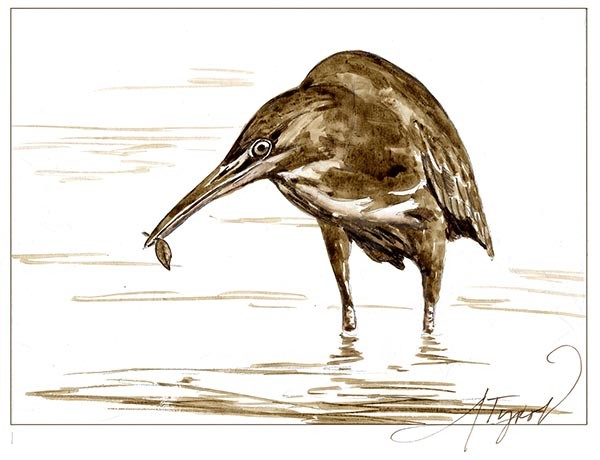
I’m always entranced watching the hunting behavior of long-legged wading birds like great blue herons and snowy egrets. They stand motionless for long minutes at the edge of a pond or swamp, waiting for prey to swim within striking distance. It’s a technique sometimes described as stalking, and it convinces me that those birds have far more patience than I do. I would go hungry if I were restricted to that strategy, since I get antsy after just a few seconds of standing motionless. I’m much more like the reddish egret of the Florida coastline, running around in knee-deep water with wings outstretched, chasing my meal rather than waiting for it to come to me.
Green herons have a hunting technique that involves neither pure stalking, nor the kinetic approach of the reddish egret. They are one of only a handful of North American bird species that are known to use tools to capture food.
The smallest of the common herons in the Northeast, green herons live around wooded lakes, ponds, marshes, and estuaries. Standing up to eighteen inches tall, they display a maroon neck and breast, a deep green back, a dark cap that is sometimes raised in a crest, and bright yellow legs. Unlike their larger, long-necked cousins, green herons usually hold their necks tight up against their bodies, giving them a stocky, hunched appearance.
Instead of getting its feet wet, the green heron typically perches on emergent vegetation or low-hanging branches at the water’s edge, and will use objects – twigs, feathers, crusts of bread – to lure fish within reach. When small fish come to investigate the object, the bird will strike, rapidly extending its neck and dagger-like beak. The victim is usually swallowed whole.
The only time I’ve observed this behavior, the heron repeatedly dropped a small dried leaf onto the surface of the water, occasionally relocating it to a preferred location as the leaf began to drift away or sink. The strategy didn’t work while I was watching, but the heron appeared to be a well-fed bird. I suspect a minnow or two met their fate that day in the form of a floating leaf.
This fishing behavior isn’t green herons’ only unusual feeding tactic. The birds have also been known to plunge completely beneath the surface to capture prey in deep water, which requires them to use the webbing between their outer toes to help them swim back to shore. (In the South, this behavior occasionally backfires when the swimming herons fall prey to alligators.)
During the breeding season, green herons share nest building responsibilities – the male selects long thin sticks that the female arranges into a shallow nest in a tree or bush overhanging the water. Whereas most herons and egrets nest in large colonies, green herons are solitary birds that prefer to raise their young in a secluded site concealed by branches. They lay three to five pale green eggs that hatch after three weeks. After the nesting season, green herons are wanderers, sometimes traveling great distances in search of good feeding habitat before migrating to Latin America in September and October.
While the birds conceal themselves well and are sometimes difficult to observe, in flight they are distinctive and noisy. Their compact bodies make them appear far less graceful than their heron relatives, and they are readily identifiable even in silhouette. Their harsh, explosive call, often given when surprised into taking flight, is also easy to identify. In my experience, that startling call more often than not sounds like the bird is scolding me for being a nuisance. It’s a result I might have avoided if only I had a little more heron-like patience.


Discussion *